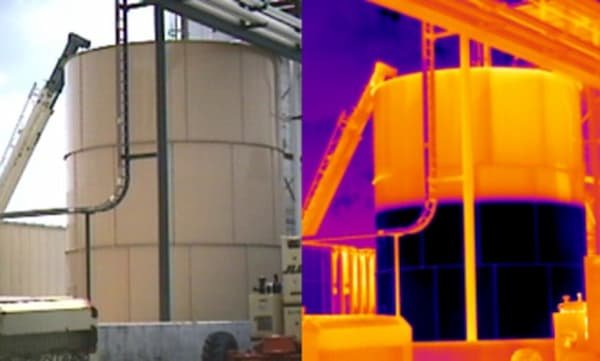Thermal imaging is a highly adaptable tool that is used by businesses for many applications. The most generalised role of these cameras is condition monitoring, but that concept can be applied in many ways. Read on to learn the two primary uses of thermal imaging cameras in this sector and the various fuel storage sites that have purchased our cameras.
24/7 Fire-Detection Thermal Cameras
The main role of these cameras is to monitor the temperature of the observed locations, and they can be programmed to alert staff members of any unexpected hot spots that emerge, as this would indicate an emerging flame. Often used as infrared fire detectors, our range of cameras is connected to advanced systems and will even have automated firefighting responses encoded to eliminate the threat immediately without waiting for human involvement.
Examples of automated firefighting responses with data supplied by our fire detection systems are turning on a sprinkler system, shutting down a system, and even targeting the hot spot to be soaked in firefighting foam.
24/7 Multipectral Security Cameras
A secondary role of these cameras is the security of your storage space. When choosing thermal or multispectral cameras for your facility's protection, you can also adapt their heat monitoring functions to monitor for unexpected intruders or vehicles.
Infrared security cameras are a common tool to upgrade your existing CCTV system as those conventional cameras will be obscured by the night or the weather; our cameras, instead, will observe a location 24/7 without interruption. These units can also be programmed to provide security alerts if an intruder is detected, prompting quick actions to protect your assets. This is especially useful for facilities where the stored fuel is outside and vulnerable to theft.
Thermal Imaging For Large-Scale Battery Fuel Storage
Another fuel source that these imaging units are being used to monitor is large-scale battery storage. With the increasing number of electric-powered vehicles on the market, there is a parallel rise in the number of fuel storage facilities storing these manufactured lithium-ion batteries. These stored units need to be monitored constantly whilst waiting to be installed in a new EV, much like any other stored fuel source.
The dormant lithium ions within the batteries have the potential to become active and generate electrical shocks and heat; whilst existing safety measures within the battery designs eliminate most of these events, there is always a small chance that electrochemical combustion will occur due to the interaction of several chemical components.
In a very short time, an initial spark will escalate into a significant fire (or even explosion), putting your manufacturing facility or storage warehouse at risk or igniting any other fuel sources nearby. In a similar role to the ones previously discussed, automated thermal imaging cameras will be installed in fixed positions around your storage area to monitor the condition of the stored batteries, such as hot spots.
Fuel Tank Monitoring and Level Measurement Inspections
Either hand-held or fixed cameras are also used to monitor the level of various liquid fuel tanks; this is achieved by analysing the temperature variations recorded and learning the current liquid-to-air ratio inside. Generally, the lower half of the tank will be distinguished as cooler than the air at the top, providing a clear result. However, this is largely due to the shifting temperatures that large outdoor tanks are exposed to during the day, creating a non-uniform temperature shift between the air and liquid inside the tank.
The oil and gas industry conducts regular tank level gauging as part of planned maintenance to look for data regarding many areas. The non-invasive method of our cameras helps engineers avoid tank overflows and calculate flow rates safely and accurately. Other elements within a tank can be viewed with one of these cameras, such as unknown solids, sludge, and contaminating foam. The varying densities are visible due to their different heat characteristics compared to the liquid around them.
By knowing the exact condition of their tanks, these invaluable areas of infrastructure will prevent any solids or sludge from being extracted along with the fuel and later cause impeller damage that would halt operations and create downtime for either your facility or your customers. Additionally, the amount of sludge in a tank will provide an inaccurate reading of how much liquid fuel is inside the tank by artificially raising the water level. Regular sludge monitoring will supply a facility manager with the data he needs to plan his next shutdown to clean out the sludge on his terms and reduce downtime further.
Automated Thermal Imagers at Thermascan
We are proud to bring you the best automated thermal imaging cameras across the UK. Our offerings include high-end models, such as this Teledyne FLIR FH-Series, designed for unmatched accuracy and precision related to condition monitoring.
Our thermal and multispectral imaging technology pinpoints even the most minor temperature variations, discerning potential issues and upholding optimal performance across various applications, from security to fire detection. To explore a thermal monitoring solution that will serve you best, feel free to contact us.





